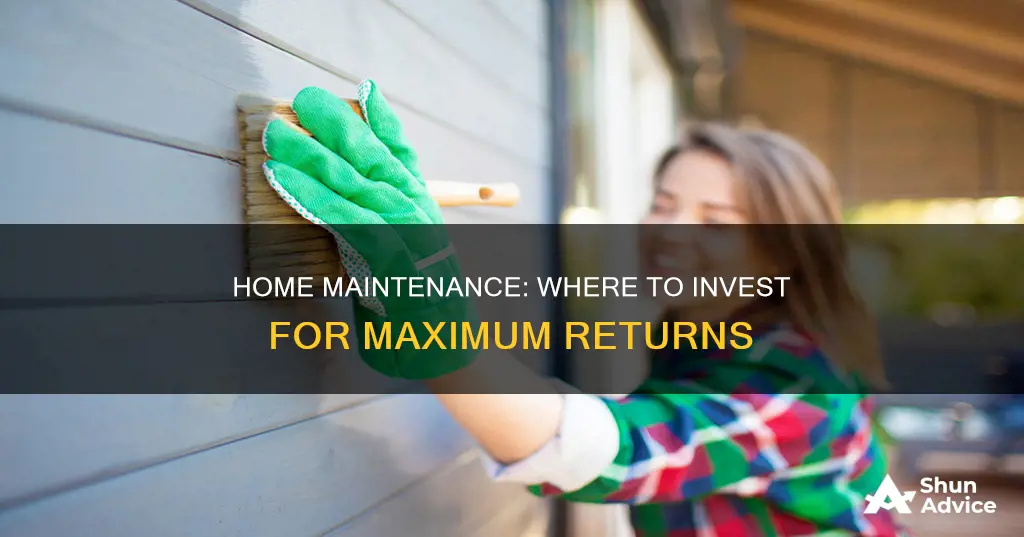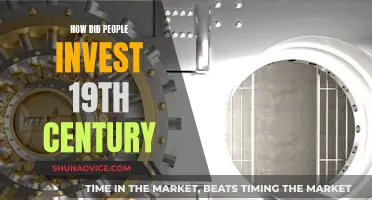
When it comes to home maintenance, it's important to consider which investments will pay off in the long run. While it may be tempting to splurge on a fancy kitchen or bathroom, basic maintenance such as roof repairs and exterior painting are often more crucial in maintaining your home's value. According to Remodeling Magazine, you're more likely to recoup your investment in basic home maintenance rather than a major remodel. For example, siding replacement yielded a 92.8% return on investment, while a minor kitchen remodel returned 92.9%. Similarly, replacing roofs and windows offered an 80% or higher return.
There are also other factors to consider when deciding on home maintenance investments. The location of your home can play a role, as certain improvements may be more valuable in specific regions. For instance, roof replacement was found to be particularly important to buyers in the eastern US, with a 96.3% return, compared to just 71.1% in the Midwest. Additionally, the housing market in your area can impact the value of your investments. In hot housing markets, kitchen and bathroom remodels often provide returns of over 100%.
Aside from the financial returns, it's essential to think about your personal circumstances and financial goals when deciding on home maintenance investments. If you plan to stay in your home for the long term, improving your daily comfort and enjoyment may be a priority. On the other hand, if you're planning to sell soon, focusing on improvements that increase your home's resale value may be more important.
In conclusion, while there are no one-size-fits-all answers, considering factors such as basic maintenance, location, market trends, and personal circumstances can help guide your decisions on which home maintenance investments will pay off.
What You'll Learn
- Basic maintenance, like roofs and exterior painting, is more important than interior work
- Bathroom additions have twice the resale value of a new bedroom
- Curb appeal is important: consider garage and entry door replacement
- Manufactured stone veneer is a cheaper alternative to natural stone
- Property maintenance includes operating and capital expenses

Basic maintenance, like roofs and exterior painting, is more important than interior work
When it comes to home maintenance, it's easy to get carried away dreaming of granite countertops and steam showers. However, if you're looking to invest in your property, it's important to remember that basic maintenance, like roofs and exterior painting, is often more important than interior work.
Exterior Maintenance Pays Off
A house's exterior is the first thing people see, and it plays a significant role in a buyer's impression of the home. A well-maintained exterior can convey a sense of welcome and make a house feel more inviting. On the other hand, a neglected exterior can be a major turn-off, causing potential buyers to lose interest before even stepping inside.
Exterior maintenance and improvements can also offer added value through energy efficiency and low maintenance. For example, replacing old windows with more energy-efficient models can help regulate your home's temperature and decrease energy bills. Similarly, siding replacement provides both aesthetic appeal and the benefit of being low maintenance, which is an important factor for cost-conscious buyers.
Basic Maintenance is Essential
While a luxurious kitchen or bathroom can be appealing, buyers are often more concerned with the state of a home's basic systems. A leaking roof, faulty plumbing, or a musty basement can be deal-breakers for potential buyers. As Ron Phipps of Phipps Realty in Warwick, RI, says, "If the roof is leaking, buyers won't get beyond that. I don't care how awesome the kitchen is."
Basic maintenance, such as a new furnace, gutters, and a drainage system to keep the basement dry, may not be glamorous, but they are essential to keeping the existing structure sound. Don Sever, a general contractor and president of Sever Construction in Oakton, VA, agrees, stating, "I've been in a lot of houses where people are spending thirty or forty thousand dollars to remodel the kitchen, but then you walk into the basement, and there's a musty smell because water is leaking through the foundation. To me, it's more important to resolve those items first and get the luxuries later."
The Bottom Line
When it comes to home maintenance investments, it's crucial to prioritize. While a dream kitchen or bathroom can be enjoyable, basic maintenance and exterior improvements are often more critical to the overall value of your home. These types of maintenance can help prevent bigger problems down the line, ensure the home's structural integrity, and make your house more appealing to potential buyers. So, if you're looking to invest in your property, start with the roof, gutters, and exterior, and work your way inwards.
S&P 500: Invest Now or Wait?
You may want to see also

Bathroom additions have twice the resale value of a new bedroom
Bathroom Additions: A Smart Investment
When considering home improvements, it's natural to want to get the most bang for your buck. One renovation that consistently delivers a strong return on investment is adding a bathroom. In fact, data shows that bathroom additions have twice the resale value of adding a new bedroom.
The Benefits of Bathroom Additions
The higher resale value of bathroom additions can be attributed to several factors. Firstly, bathrooms are considered high-value areas of the home, as they tend to be more expensive to construct than other rooms. As a result, investing in a bathroom addition can significantly increase the overall value of your home.
Secondly, the addition of a second bathroom can be a strong selling point for potential buyers, especially those with larger families. A National Association of Realtors study found that adding a bathroom increased the sale price of a home by 8.7%, more than double the rate for adding a bedroom.
Furthermore, in today's market, certain features are particularly sought-after in bathrooms. For example, walk-in showers have replaced whirlpool tubs as a must-have, as most people opt for quick showers over baths. Additionally, free-standing tubs, storage space, and modern fixtures can all enhance the appeal and value of a bathroom.
Cost Considerations
The cost of adding a bathroom varies depending on several factors, including the size and type of bathroom, as well as whether you're making an addition to the home or remodelling an existing space. According to Remodeling magazine, a midrange bathroom addition costs an average of $49,596, with an ROI of 54%Upscale bathroom additions can run upwards of $90,000, with a similar ROI of around 55%
It's worth noting that even smaller updates to an existing bathroom can make a significant difference in its value. Simple changes like updating flooring, paint, lighting, or fixtures can increase your home's value by a few percentage points and provide a strong return on investment.
Location and Market Considerations
When considering the resale value of any home improvement, it's essential to look at the specific market and location. For example, in hot housing markets, investing in a bathroom remodel can be a sure-fire investment, often returning more than 100% of the cost. In Baltimore, a $9,400 bathroom remodel recouped 182% of its cost at resale, according to a 2004 study.
Additionally, the demand for certain features may vary by region. For instance, in colder climates, buyers may place a higher value on features like heated floors or higher insulation.
If you're looking to invest in your home, a bathroom addition or renovation is a smart choice. Not only does it offer a strong return on investment, but it also makes your home more appealing to potential buyers. However, it's important to consider your specific market and location, as well as the types of features that are in demand. By making strategic choices, you can maximize the resale value of your home improvement projects.
Solar Energy: The Rapid Return on Investment
You may want to see also

Curb appeal is important: consider garage and entry door replacement
Curb appeal is a crucial factor in the real estate market, and one of the most prominent elements of a house's façade is the garage door, which on average, takes up 30% of the exterior. Upgrading your garage door can instantly enhance your home's curb appeal and increase its market value. It is also one of the home maintenance investments with the highest returns. According to HGTV, replacing a 16' x 7' garage door with a steel door, foam insulation, tracks, and insulated glass windows in the top panel costs an average of $4,513, with a resale value of $8,751, yielding a remarkable 193.9% return.
Garage doors come in various styles and materials, including steel, fiberglass, wood, and composite wood, each offering distinct advantages. Steel doors are generally more affordable, while wood doors can be more expensive but are prized for their natural aesthetic. Composite wood, although pricey, is known for its durability and low maintenance.
Additionally, consider matching your garage door to your home's architectural style and adding decorative windows or hardware to create a cohesive look. Don't forget to explore lighting upgrades and the option of an automatic garage door opener to further enhance functionality and curb appeal.
The entry door, or front door, is another vital aspect of curb appeal. Opting for a steel door with a dual-pane half-glass panel costs an average of $2,355, with a resale value of $4,430, resulting in an impressive 188.1% return. When choosing a new front door, it's essential to strike a balance between personality and cohesiveness with the rest of your home's exterior.
In conclusion, investing in garage and entry door replacements can significantly boost your home's curb appeal and provide substantial returns. With careful consideration of style, material, and additional features, you can elevate the exterior of your home while also making a sound financial decision.
LetGo: Why Venture Capitalist Investments?
You may want to see also

Manufactured stone veneer is a cheaper alternative to natural stone
If you're looking to elevate the appearance of your home, manufactured stone veneer is a great option. It is a more affordable alternative to natural stone, offering the same curb appeal at a fraction of the price and with easier installation.
Natural stone is one of the most expensive building products. It is beautiful and authentic, but the installation process is lengthy and costly, requiring an experienced mason. Natural stone is also heavy and dense, and upkeep can be challenging.
Manufactured stone veneer, on the other hand, is designed to look and feel like natural stone but is pre-engineered for easy installation. It is made from a mixture of cement, natural aggregates, and pigments, and it can be used on a home's exterior or interior. It is also much lighter than natural stone, making it more versatile and suitable for applications that cannot support the weight of natural stone.
According to Remodeling Magazine's 2020 Cost vs. Value Report, replacing vinyl siding with manufactured stone veneer can recoup nearly 96% of the project's cost. The average cost of adding 300 square feet of manufactured stone veneer to the bottom third of your facade is $11,287, and you can expect an average resale value of $17,291.
When choosing manufactured stone veneer, consider colours and styles that complement your home's exterior, such as paint colour and architecture. Popular colours include beige-and-cream or gray-and-blue palettes, and common textures include irregular shapes with a cobblestone feel or rectangular shapes with clean edges.
Understanding the Cost of Expertise: Unraveling Investment Advisor Fees
You may want to see also

Property maintenance includes operating and capital expenses
Rental property maintenance expenses include garden, yard or outdoor area maintenance, general cleaning and chemical costs for swimming pools, light bulbs and batteries on smoke detectors, and repairs for gardening equipment. Some of the most common repair requests are plumbing leaks, appliance breakdowns, clogged sinks and toilets, bugs, and roof leaks.
Capital expenses (CapEx) are the second classification of costs and enhance the condition of the property and extend its life. These include replacing or adding new appliances, HVAC (Heating, Ventilating, and Air Conditioning), and remodelling bathrooms and kitchens.
The cost of property maintenance depends on factors such as the size, condition, and age of the property, as well as the type of property. Larger properties with additional features may require higher maintenance budgets.
There are several methods to allocate your maintenance budget, such as the 50% rule, which suggests that total operating expenses may amount to 50% of the income generated by the rental property. The 1% rule considers the annual property value and suggests that total operating costs could take up to around 1% of the property value per year. The 5X rule fuses monthly rental income with annual maintenance costs by multiplying the monthly rent by 1.5.
Classroom Tech: Investments and Innovations
You may want to see also







